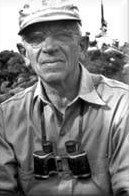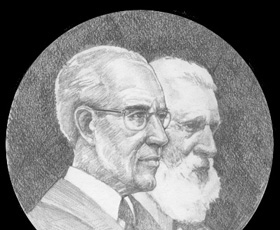the john muir exhibit - people - aldo leopold
Aldo Leopold
1886 - 1948
- Leopold was an original thinker helping to take conservation to new heights.
- Aldo Leopold was a pioneering scientist in the fields of forestry, soil conservation, wildlife management, and wilderness preservation. He is best known today for his still-influential book A Sand County Almanac. According to Robert Finch, "No other single book of American nature writing - with the exception of Walden - has achieved such lasting stature as A Sand County Almanac. Since it was first published by Oxford in 1949, one year after the author's death, it has become an established classic in the field, admired by an ever-growing number of readers, imitated by hundreds of writers, and providing the core for modern conservation ethics."
- Leopold was a co-founder of The Wilderness Society.
- Aldo Leopold's seminal essay about the "land ethic" has been conceived as a turning point in conservation philosophy. He wrote, "we abuse land because we regard it as a commodity belonging to us. When we see land as a community to which we belong,we may begin to use it with love and respect... A thing is right when it tends to preserve the integrity, stability, and beauty of the biotic community. It is wrong when it tends otherwise." Read Leopold's A Land Ethic online here.
- According to Leopold biographer Curt Meine, the tension between the utilitarian and preservationist views existed within Leopold: he held both a Muir-like appreciation of nature, but also a Pinchot-like intent to use nature wisely.

- Leopold copied down a quote from Muir that was to pre-sage Leopold's eventually-adopted view that all wildlife - even predators like wolves, bears, and snakes - had value: "Poor creatures, loved only by their Maker, they are timid and bashful, as mountaineers know; and though perhaps not possessed of much of that charity that suffers long and is kind, seldom, either by mistake or by mishap, do harm to any one.... Again and again, in season and out of season, the question comes up, "What are rattlesnakes good for?" As if anything that does not obviously make the benefit of man had any right to exist; as if our ways were God's ways."
- In A Sand County Almanac, Leopold mentions John Muir's Wisconsin experiences, and, like Muir, decries the loss of the now-extinct Passenger Pigeon.
- As a university professor, Leopold recommended students read Muir's The Story of My Boyhood and Youth due to its evocative descriptions of frontier Wisconsin. Noting that the Muir farm has become depleted floristically and otherwise, he nonetheless suggested that Muir's frontier farm of his boyhood be made a state park. Today, much of Muir's boyhood home at Fountain Lake is a 125 acre county park, a national historic landmark, Native vegetation is being restored, and the adjacent Wisconsin Department of Natural Resources land surrounding Ennis Lake (which the Muir family called "Fountain Lake") includes a trail that circles the lake and passes through 7 different habitats.
- Aldo Leopold is sometimes considered part of a historic conservation triumvirate coming out of Wisconsin, humorously expressed by the newspaper The Capital Times on March 26, 1990 in an essay for the 20th anniversary of Earth Day: "In the beginning there was John Muir, who begat Aldo Leopold, who begat Gaylord Nelson, who begat Earth Day."
- For an analysis of Wisconsin's "environmental triumvirate," see Three Degrees of Separation: Wisconsin's Environmental Legacy by Michael Edmonds, in the Wisconsin magazine of history: Volume 100, number 4, summer 2017. (Interestingly, due to newspapers not keeping their archived articles online, Edmonds credits this quote back to this website, whereas we clearly credit the original quotation being published by an unknown author in The Capital Times back in 1990.)
- Sculptor James Muir was so inspired by the idea of the "Wisconsin conservation triumvirate" that he created a sculpture entitled "the Begats" which portrays Muir, Leopold, and Nelson in discussion together.
- For an engaging illustrated essay from a geographic / travel viewpoint, see History On The Road: John Muir and Aldo Leopold in Wisconsin by Thomas J. Straka and James G. Lewis in Forest History Today (Spring/Fall 2015).
- To learn more about Aldo Leopold, see:
Home
| Alphabetical Index
| What's New & About this Site